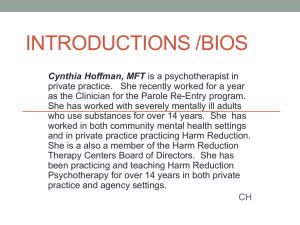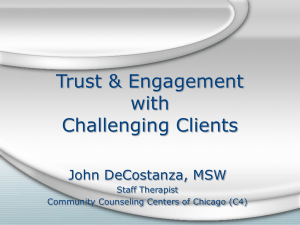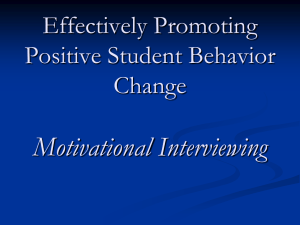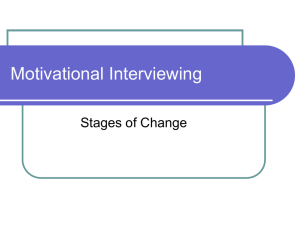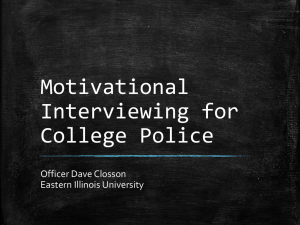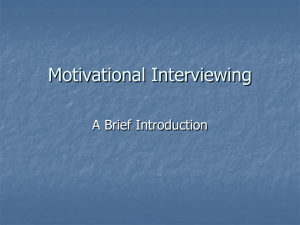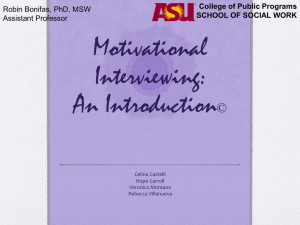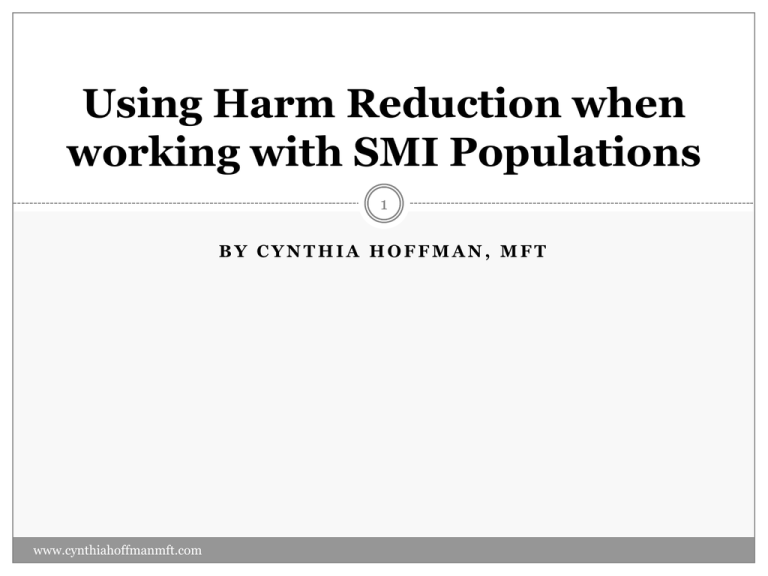
Using Harm Reduction when
working with SMI Populations
1
BY CYNTHIA HOFFMAN, MFT
www.cynthiahoffmanmft.com
2
www.cynthiahoffmanmft.com
Presenter Biography
3
Cynthia Hoffman, MFT is a psychotherapist
in private practice. She also currently
volunteers supervision to interns working in
Community Mental Health settings. She has
worked with severely mentally ill adults who
use substances for over 13 years. She has
worked in both community mental health
settings and in private practice, practicing
Harm Reduction. She is a also a member of the
the Harm Reduction Therapy Centers Board of
Directors. She has been practicing and teaching
Harm Reduction Psychotherapy for over 13
years in both private practice and agency
settings.
www.cynthiahoffmanmft.com
www.cynthiahoffmanmft.com
Workshop Objective
4
Objective: To familiarize the attendees with ACT and
similar programs that work with homeless or
previously homeless psychiatrically ill adults who have
co-occurring substance use issues along with cooccurring medical illnesses and to identify the Harm
Reduction techniques used with this population.
www.cynthiahoffmanmft.com
What is Assertive Community
Treatment (ACT)?
• How the program
•
•
•
•
www.cynthiahoffmanmft.com
works/History
Who ACT serves
Living situations
Working with all providers:
Benefits of ACT
5
How Act Works
6
An ACT team is made up of multi-disciplinary staff
that generally includes case managers, nurses,
psychiatrist(s) and mental health clinicians.
ACT operates from a “whatever it takes” philosophy
and services are provided “in-vivo”. ACT programs
were initially created to be a “hospital without walls”.
www.cynthiahoffmanmft.com
Who ACT serves
7
Typical ACT clients may present with a variety of
diagnoses including (but not limited to):
Schizophrenia, Bipolar Disorder, Personality
Disorders and Substance Abuse Disorders .
Additionally, they are also likely to have health
conditions, developmental disorders and
environmental stressors.
Many are homeless or formally homeless.
www.cynthiahoffmanmft.com
8
www.cynthiahoffmanmft.com
9
Housing
Clients in an ACT program may live in a
variety of housing situations. Many are
homeless or at least homeless for periods
of time.
Some live in supervised board & care
homes and some may live independently
in apartments or SRO’s (single room
occupancy hotels).
These housing situations often present
barriers in treating clients from a harm
reduction approach.
www.cynthiahoffmanmft.com
10
www.cynthiahoffmanmft.com
Other Providers
11
An essential component of an ACT program is the
collaboration with other providers to ensure a
strong continuum of care.
payee services
conservators
housing staff
hospital staff
adjunct substance abuse services
Helping to educate other providers on the benefits
of a harm reduction approach can present
challenges and is often met with resistance.
www.cynthiahoffmanmft.com
Benefits of ACT
12
Studies show that substance use is
reduced when wraparound case
management along with providing social
skills significantly reduces a clients
substance use, sometimes by 50%
Socialization, a sense of belonging
Main focus of ACT is helping clients to
improve their quality of life and develop
meaningful activities
www.cynthiahoffmanmft.com
13
www.cynthiahoffmanmft.com
Typical ACT client
14
Adult 18 – 70 Average age approx 40
People of color
Poor
Former foster children
Homeless or Minimally Housed
www.cynthiahoffmanmft.com
Why SMI populations drink and use
15
People with mental illness use substances for a
variety of reasons, including the relief of depression,
anxiety, boredom or to relax and socialize
(Addington & Duchak 1997, Fowler et al. 1998),
www.cynthiahoffmanmft.com
Substances used:
•
•
•
•
•
•
Alcohol
Crack
Speed
Heroin
Marijuana
Prescription Drugs: i.e. Oxycontin, Klonopin
www.cynthiahoffmanmft.com
16
Interventions
17
•
•
•
•
•
•
INTENSIVE CASE
MANAGEMENT
PSYCHIATRIC
INTERVENTIONS
INDIVIDUAL SUPPORTIVE
THERAPY
GROUP THERAPY
TEACHING SELF CARE
INCENTIVES
www.cynthiahoffmanmft.com
Intensive Case Management
18
Both short and long term goal setting (which
includes goals that add meaningful activities to a
clients life)
Medical appointments
Help with entitlements
Communication with families
Psychiatrist
Case managers rotate 24 hour on call for off hours
www.cynthiahoffmanmft.com
Psychiatric Interventions
19
ACT psychiatrist meets with the client as needed
which could be from weekly to monthly. These
appointments can be in the office, at the clients
home or at a café.
Collaborates WITH the client in developing an
effective medication regimen, taking into account
the substances a client uses.
Discusses substance use and its effects when
combined with medications
May prescribe vitamins and/or behavioral
interventions (CBT, DBT, etc) instead of or in
conjunction with psychiatric meds
www.cynthiahoffmanmft.com
Individual and Group Therapy
20
Individual Therapy is supportive and about teaching
coping skills.
Group Therapy is mostly
psycho-educational and open-ended
www.cynthiahoffmanmft.com
21
“I’ve never had
problems with
drugs. I’ve had
problems with the
police.”
Keith Richards
www.cynthiahoffmanmft.com
Motivational Interviewing
22
Whole package of Motivational Interviewing is complicated and
there is much to learn. The spirit of MI is what’s essential.
The Spirit of Motivational Interviewing
Collaboration
Evocation
Autonomy
Perception
Curiosity
Ethics
Treats Resistance as thinking
www.cynthiahoffmanmft.com
Principles of Motivational Interviewing
23
Express Empathy- Be affirming, help clients express
their personal choice
Develop Discrepancy – Develop the discrepancy between
the clients goals and their current Behavior
Roll with Resistance – Avoid Arguments – Know that
resistance is a form of thinking about the issue
Support Self Efficacy
www.cynthiahoffmanmft.com
Individual Therapy
24
Supportive
Client Centered
Motivational Interviewing
Individualized Personal Goals
Quality of Life Issues
Individualized Harm Reduction Strategies
Identifying and helping client work towards
goals that provide meaningful activities
www.cynthiahoffmanmft.com
Motivational Interviewing
Whole package of Motivational Interviewing is complicated
and there is much to learn. The spirit of MI is what’s
essential.
The Spirit of Motivational Interviewing
Collaboration
Evocation
Autonomy
Perception
Curiosity
Ethics
Treats Resistance as thinking
26
www.cynthiahoffmanmft.com
Group Therapy
27
Groups provided:
Health Groups: Diabetes/High Blood Pressure
Women’s/Men’s Groups
Anger Management
Socialization Groups – Lunch Group, Weekend
Planning, Holiday Celebrations, Knitting,
Walking, Music Group
Art Therapy
Seeking Safety
www.cynthiahoffmanmft.com
Group Therapy (continued)
28
Harm Reduction. Includes topics:
Stages of change
Personal Goals
Family influence
Dealing with Feelings
Drug education including safer use
www.cynthiahoffmanmft.com
Teaching self care to SMI population
• Physical - wound care, dental, checking BP,
blood sugar, liver panel regularly
• Psycho-education about physical health, psychiatric
illness, substances used
• Prescribing vitamins i.e B6,
• statistics re: smi populations --50 to 80%
• Safe Injection, clean works and pipes, drinking
water
• Diabetes and High Blood Pressure Education
www.cynthiahoffmanmft.com
29
Incentives
30
Incentives are offered for a variety of issues. They can be
used to encourage someone to:
o take a shower
o attend a group
o reduce use or
o go on a substance use holiday
Some examples of incentives used are:
Food shopping
Clothes or household items shopping
Visits to a massage parlor
Musical instruments
A meal at a favorite restaurant
www.cynthiahoffmanmft.com
Incentives (cont)
31
Some examples of incentives used are:
Food shopping
Clothes or household items shopping
Visits to a massage parlor
Musical instruments
A meal at a favorite restaurant
www.cynthiahoffmanmft.com
Sex
32
Severely Mentally Ill and DD clients have sex.
Oftentimes, alot of it.
Provide Harm reduction education about sexual
practices
www.cynthiahoffmanmft.com
Countertransference
33
Many come to social because of family issues
experienced when growing up. To experiences are
likely to arise when working with clients. These
should be recognized and discussed in individual
supervision with the supervisor taking care not to act
as therapist to the staff member.
www.cynthiahoffmanmft.com
Working with staff, burnout
34
frustration at seeing these adults make bad choices
Anger at the system
The ACT Team Model allows for team members to
help each other in a variety
of ways i.e. going on outreach together,
taking over if one person is ‘burnt out’ on a particular
client
www.cynthiahoffmanmft.com
Challenges and Obstacles
35
Funding
Stress from everyone to keep clients out of the
hospital even though the hospital might be what they
need
Growing acuity levels in clients while resources
continue to shrink.
www.cynthiahoffmanmft.com
Contact us
cynthiahoffmanmft@yahoo.com
www.cynthiahoffmanmft.com
36
www.cynthiahoffmanmft.com

